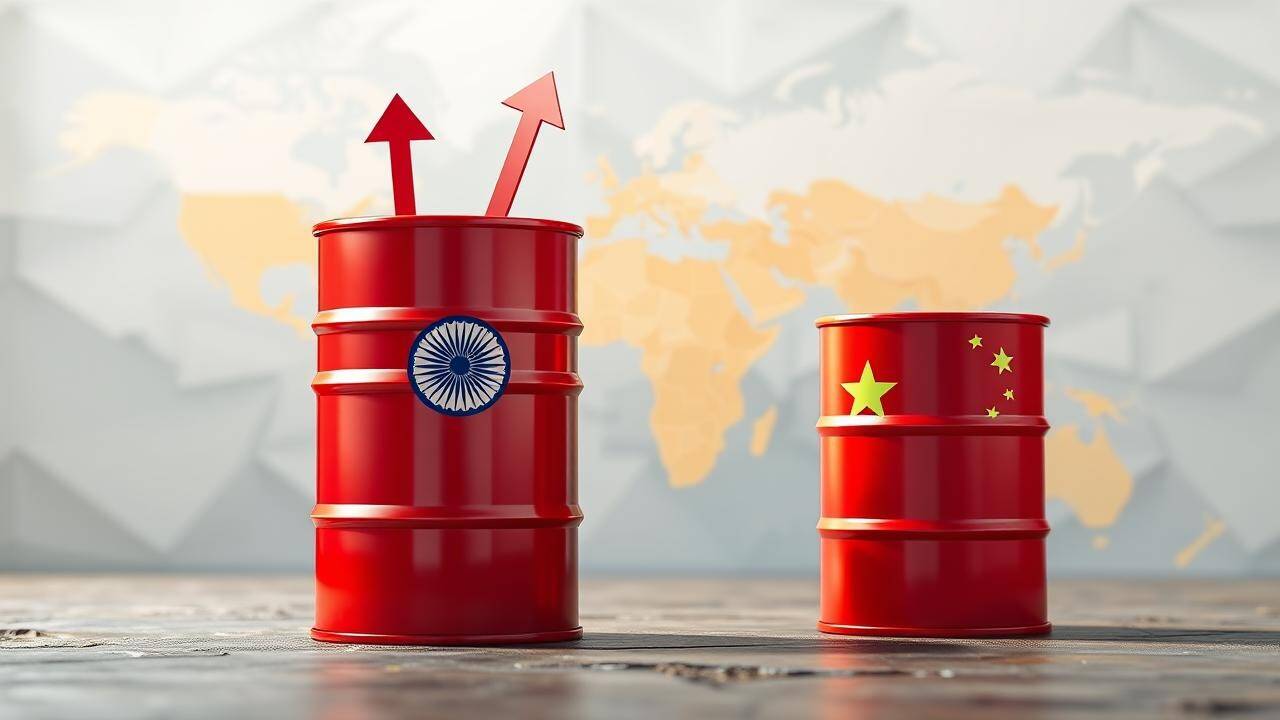
New Delhi: China drove global oil demand growth over the last decade, but now India is poised to take the lead in demand growth over the next decade, according to a latest report by Moody’s Ratings. China and India are No. 2 and No.3 oil consumers in the world. But there are notable differences in demand growth in the two countries.
“Demand growth and import reliance will be higher in India,” Moody’s said. “Demand will grow faster in India than in China over the next decade, as China’s economic growth slows and penetration of new energy vehicles accelerates.”
Consumption of crude oil – the raw material for making fuels like petrol and diesel – in China will peak in the next 3-5 years, while in India Moody’s expect annual growth of 3-5 per cent in the same period.
Stating that both countries rely heavily on oil and gas imports, the rating agency said it expects China’s reliance on oil imports to fall, reflecting slower demand growth and increased domestic production.
“India’s reliance on imports will increase if it is unable to stem a production decline,” it said.
Moody’s said China’s larger oil and gas consumption underpins the scale of its national oil companies (NOCs), which will likely outpace their Indian peers in production growth over the next 3-5 years.
Investments in complex shale gas and offshore projects bolster Chinese NOCs’ reserves and production, while Indian NOCs face challenges from aging wells and slow investment. Additionally, Chinese NOCs’ greater value chain integration mitigates earnings volatility, and they have lower leverage and higher interest coverage. Moody’s saw investment focus vary, reflecting national objectives.
“Chinese NOCs continue to invest heavily in exploration and development to enhance self-sufficiency. Their investments in the downstream refining and petrochemical sectors will gradually decline over the next 3-5 years as most major projects have been completed. By contrast, NOCs in India will still invest heavily to expand refining and petrochemical facilities over the next five years to meet growing domestic demand,” it said.
“Indian NOCs plan to boost domestic oil and gas production but execution remains to be seen,” it added.
Government policies in China are more market-oriented, it said, adding that policies in both countries are aimed at maintaining price stability and adequate supply.
“The effect of policy is more pronounced on companies in India as pricing mechanisms have led to bigger swings in earnings and cash flows. India relies more on taxes and dividends from its petroleum sector to support its fiscal budget than China,” it said.
As carbon regulation in India is still developing, Indian NOCs face less immediate pressure to invest in green technologies compared to Chinese NOCs, which face stricter rules and the need to transition to green practices more quickly.
Both countries rely heavily on oil and gas imports. But Moody’s expected China’s reliance on oil imports will fall, driven by slower demand growth and its push for self-sufficiency amid geopolitical tensions.
China’s oil demand is expected to grow marginally to peak at around 800 million tonnes per annum (mmtpa) by 2030. Apart from slower economic growth, China’s oil demand growth is also constrained by the country’s shift toward cleaner energy.
Fast adoption of NEVs (New Energy Vehicles) and the expansion of renewable energy will reduce China’s need for oil products like diesel and gasoline. However, the country’s consumption of jet fuel and naphtha will likely rise because of increasing air travel and petrochemical production.
Refining capacity in China is also near the state-mandated cap of 1 billion tonnes. This limits the potential for demand growth of crude oil, which is the feedstock for refineries. By contrast, India aims to increase its refining capacity by a fifth to 309.5 mmtpa by 2030 from 256.8 mmtpa as of April 1, 2024.
Rising economic growth and industrialisation, along with the government’s heavy investments in infrastructure that will enhance accessibility and mobility, will drive demand growth for transportation fuels in India.
The state-owned oil marketing companies (OMCs) in India – Bharat Petroleum Corporation Ltd, Hindustan Petroleum Corporation Ltd and Indian Oil Corporation – have ramped up investments to boost refining capacity in recent years.
On gas demand, Moody’s said the pace of demand growth for natural gas in India will be slightly higher than China’s.
Compared to thermal coal and diesel, gas is a cleaner fuel and feedstock and is thus commonly viewed as a key transition fuel for a lower-carbon future.
India aims to boost the share of natural gas in its energy mix to 15 per cent by 2030 from about 6 per cent now. The expansion of industrial sectors such as fertilisers and petrochemicals, which use gas as feedstock, along with higher consumption of natural gas in urban and semi-urban areas, will support demand growth of 4-7 per cent per year in India through 2030.
The use of compressed natural gas and piped natural gas in cities, for both transportation and household energy needs, has been on the rise. But the hurdles to further growth include gas connectivity within the country, as well as affordability, given the presence of cheaper alternatives like renewables, it added.
China’s push for self-sufficiency will drive lower reliance on imports, while India’s self-sufficiency will likely weaken China and India both rely heavily on oil and gas imports. China currently imports more than 70 per cent of crude and 35-40 per cent of its natural gas requirements, with the rest supplied by domestic production. India imports close to 90 per cent of its crude needs and about 50 per cent of its gas needs.
“The high level of import dependence has raised significant concerns about energy security in both countries. These concerns are particularly acute for China, given rising geopolitical risks,” Moody’s said.



